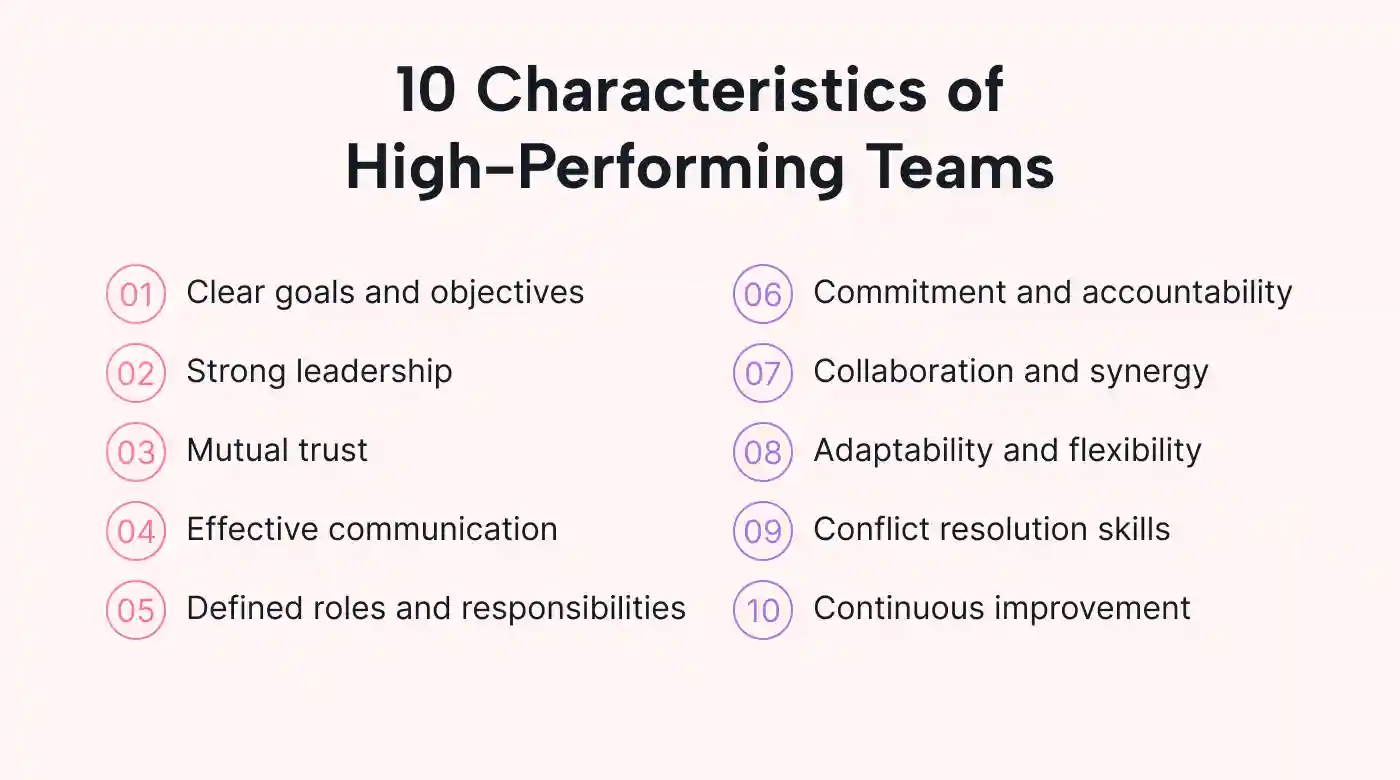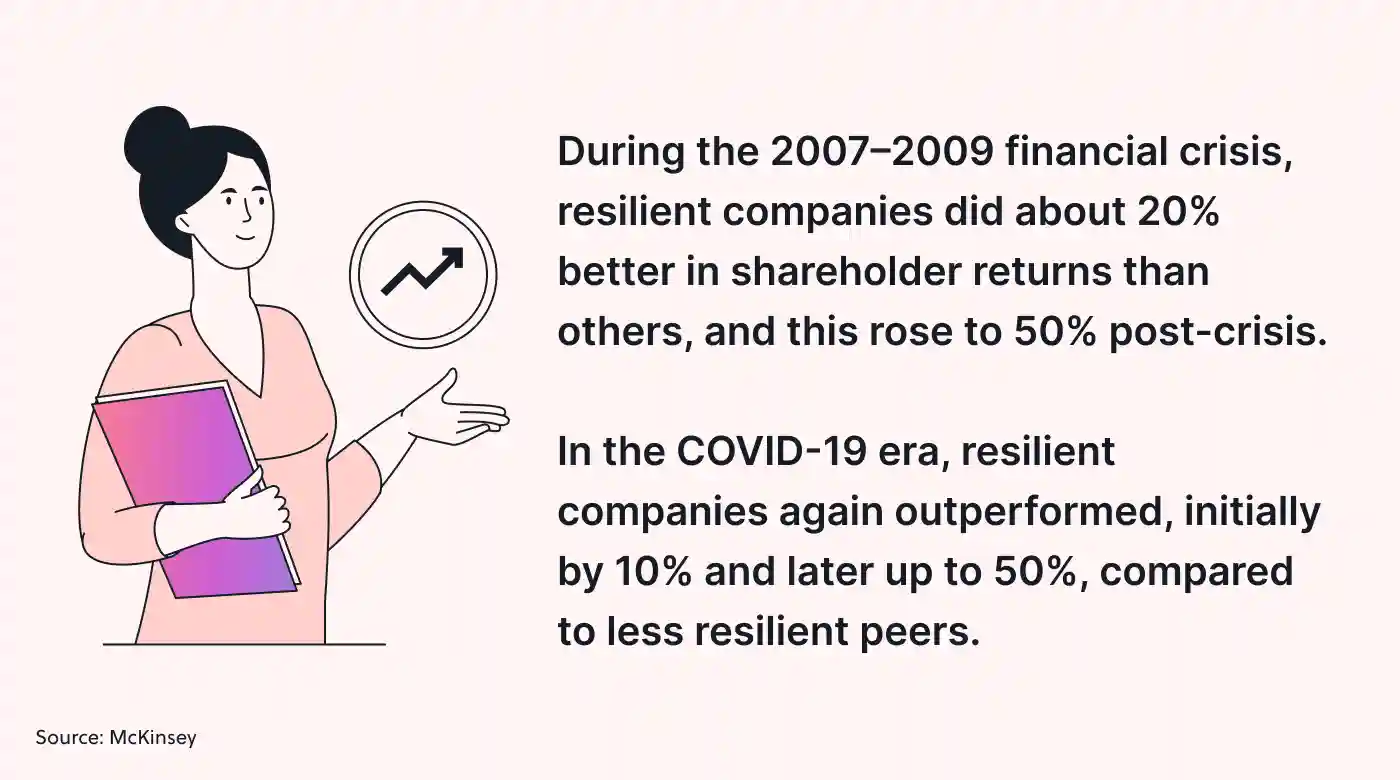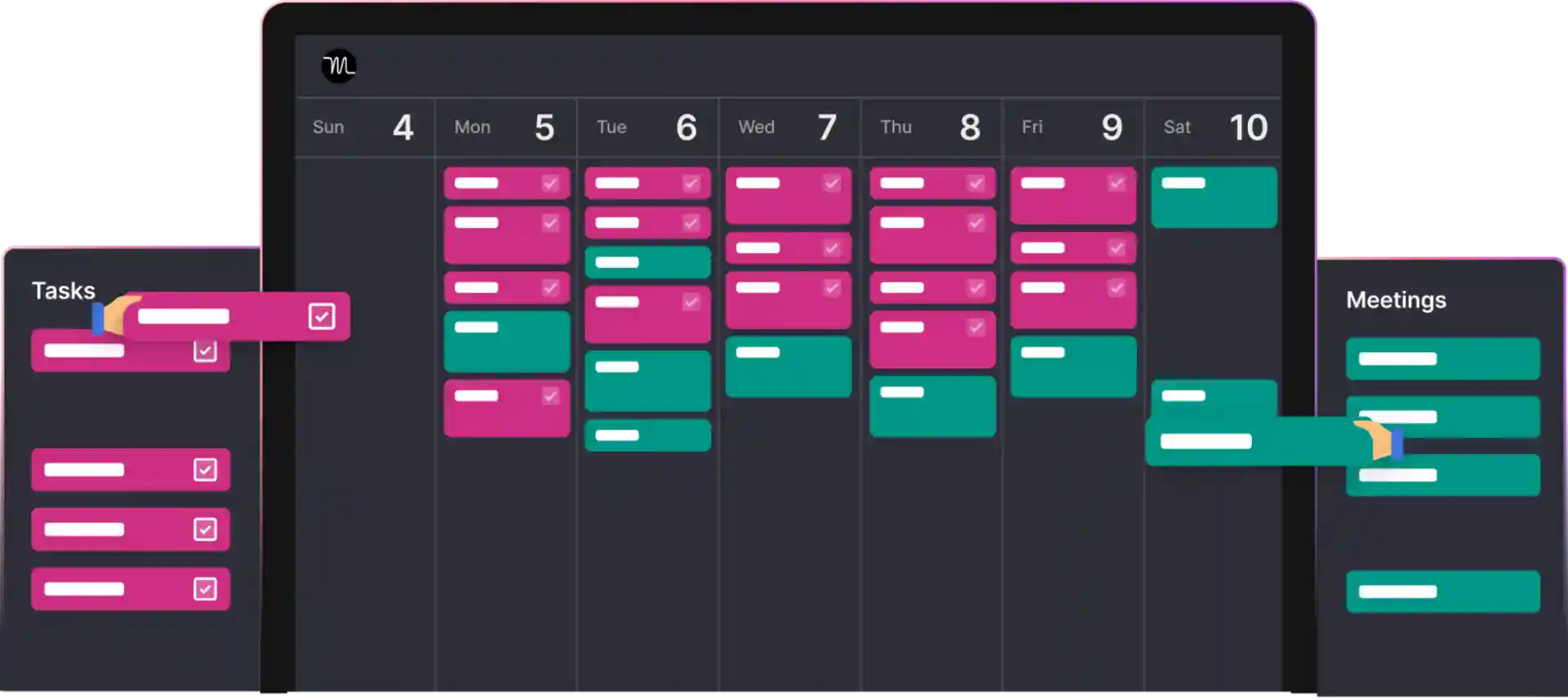High-performance work teams: We all want them.
And for good reason. They churn out success after success. They’re focused. They communicate clearly. And they have a relentless drive for results.
But how do you build them?
In this article, we’ll explore the nuts and bolts of successful teams. We’ll also share practical, actionable strategies to transform any team into a powerhouse.
What are high-performing teams?
A high-performing team is a group of people who work exceptionally well together to achieve their organizational goals. They're typically innovative, great at problem-solving, and efficient regarding high-level communication and collaboration.
High-performance teams also tend to self-organize to reach common goals.
But what makes them top-notch is how they leverage their collective talents, expertise, perspectives, and skills to produce superior results.
10 characteristics of high-performing teams
Here are 10 key characteristics you can expect from high-performing teams:
 |
1. Clear goals and objectives
High-performing teams put their team goals and objectives at the forefront.
Each team member is focused on their objectives. They also have a clear understanding of how their hustle aligns with the team's purpose and the larger organizational objectives. Their focus helps make their goals well-defined and achievable.
As a result, deeper connections to the team's mission are formed. This only adds to the team's motivation (and performance).
2. Strong leadership
High-performing teams don’t become high-performing without effective leadership.
A strong team leader gives the team direction, incorporates regular feedback, cares about the psychological safety of the team, and always looks for opportunities to boost team morale.
They do so via collaborative leadership, where each team member has a say in the decision-making process. This helps foster a sense of accountability.
3. Mutual trust
How do people rely on others to complete tasks without direction? Or work independently without the need for micromanagement?
The answer is trust, the heart of high-performing teams.
Trust creates a safe space for psychological safety. This allows team members to rely on each other’s expertise and abilities to achieve shared goals.
4. Effective communication
If there is ever a secret sauce to high-performance teams, it's communications.
Effective communication means minding communication preferences and open lines of communication. In turn, this leads to.
- Information flows smoothly and is readily available
- Team members learn to listen to each other
- Team members can exchange information freely
- Problems are addressed and resolved promptly
- Clients and customers receive prompt updates
Proper communication also helps build transparency, trust, and a feedback culture.
5. Defined roles and responsibilities
High-performing teams have well-defined team roles and responsibilities, so everyone knows what's expected of them. This allows team members to bring their A-game, resulting in minimal conflict, better coordination, and higher productivity.
Moreover, when roles and responsibilities are clear, team members have a deeper understanding of what it takes to get projects across the finish line, and it breeds a sense of accountability.
6. Commitment and accountability
Speaking of accountability, it and high-performing project teams go hand in hand.
Accountability (or ownership) comes from letting people contribute ideas and then running with the ideas that get you to your business goals.
And accountability is a hallmark of self-organized teams, which, in turn, leads to a positive team culture.
Win-win-win.
7. Collaboration and synergy
Collaboration is key to sustaining high-performing teams. It’s through collaboration that team members recognize and leverage each other’s strengths. At the same time, it provides teams with the opportunity to recognize and make up for each other’s weaknesses.
The result? A team that packs power into a culture of inclusivity and innovation — with its members always open to learning from one another and having a common understanding of the importance of synergy.
 |
8. Adaptability and flexibility
High-performing teams are adaptable. Throw them a curve ball and watch them quickly adapt.
How is this possible?
Capable teams are always:
- Ready to help team members in need
- Assessing priorities and shifting gears as needed
- Ready to wear multiple hats during a crisis
- Encouraging each other when a change is causing stress
- Communicating promptly to avoid conflicts and delays
9. Conflict resolution skills
High-performing teams aren't safe from conflict. It's bound to happen when you have a group of people working together. It's called the storming stage.
However, these types of teams' effective approach to conflict resolution is part of what makes them high-performing.
They employ effective strategies to solve conflicts (and keep progress on course).
Most importantly, it creates a healthy team dynamic that allows members to ask for help or share opinions freely.
10. Continuous learning
There's always room for improvement, no matter how high-performing a team is. What separates effective teams from average ones is their willingness for continuous learning (and improvement).
Why?
Continuous learning helps them improve their skills to keep up with competitors, industry standards, regulations, and market trends. This is a crucial differentiator in the eat-or-be-eaten business world.
6 tips for building high-performing teams
You now know what characteristics to expect from high-performing teams. But how do you put together a team that’ll develop these characteristics?
Here are six tips:
1. Hire the right people
You can achieve project success with an average team, but a high-performing team requires talent. You need individuals who have the skills your project or organization requires. This allows the team members to play off each other's strengths.
Quality hires will also bring diverse perspectives that challenge teammates and increase motivation and engagement. The benefit? Higher-quality results.
Pro tip: If you want a high-performing team, don't take hiring lightly. Only 5% of employees deliver 95% of an organization's value. And the highest performers are 800% more productive than average performers in the same role.
Consider the benefit of bringing on an ace developer or designer who's 800% more productive than most. Your bottom line will also thank you.
Here are some hiring tips that can come in handy:
- Be honest and clear about roles and expectations.
- Make job descriptions very detailed.
- Evaluate your team dynamics and share them during interviews. See how each candidate might fit into your team culture.
- Include your current team members in the hiring process to get their feedback.
2. Embrace diversity and inclusion
Diversity and inclusion are always fun because you can embrace and interact with different backgrounds and cultures.
More than that, it also brings a broader range of perspectives that challenge current employees to improve their abilities and performance. Embracing diversity can also help make your team more flexible and adaptive (and a powerhouse of innovation and creativity).
Ready for inclusion? Start by:
- Implementing unbiased recruitment practices
- Fostering an inclusive company culture
- Encouraging diverse thinking
- Organizing diversity awareness programs
 |
3. Recognize and reward good performance
Recognition goes a long way when it comes to motivating employees and encouraging them to produce high-quality output. So, don’t be afraid to let your team members know when they do a good job. Maybe even throw in rewards to boost employee engagement.
What’s in it for you? You reinforce desired behaviors and promote continuous improvement while creating a healthy work environment! (Hello, higher retention rates!)
Ready to brag about your team? Here are some quick tips:
- Acknowledge good performance as soon as you see it, and do it often.
- Call out solid performers by name, and don’t shy away from publicly bragging about them! Let the team know who’s doing it right.
- Personalize the rewards; e.g., add recipients’ names to them.
4. Provide necessary tools and resources
When your team has access to the right tools to do their jobs, you've already put them on the road to success. These tools include task management, operational, time tracking, and training software.
The benefit? You instantly improve your team’s efficiency, productivity, and skill utilization, allowing for more productivity. Not to mention, your employees will appreciate the convenience.
But what tools do you need? The answer to that lies in your team’s requirements. For instance, does your team need help automating meetings? Assigning tasks? Tailor your tools to what your team needs to do their jobs efficiently.
Pro tip: Don’t forget to offer training and support when introducing new tools.
5. Foster adaptability and problem-solving skills
You want your team to be able to respond to change and quickly find innovative solutions.
Resilience is important, too. During the 2007–2009 financial crisis, resilient companies did about 20% better in shareholder returns than others, and this later rose to 50%. In the COVID-19 era, resilient companies again outperformed, initially by 10% but later up to 50%.
Here are some ways to help your teams develop adaptability and problem-solving skills:
- Expose them to various tasks and challenges so they become adept at handling many scenarios.
- Allow appropriate risk-taking.
- Encourage constructive feedback and ideas for improvement. You never know who'll develop a top-notch solution to an ongoing issue.
- Encourage collaborative problem-solving.
 |
6. Balance your team’s workload
The last thing you want is for your high-performing team to be stressed out. After all, if they are stressed, they won't be high-performing for long. They might even experience employee burnout. No bueno.
Keep an eye on their workload to ensure optimal team performance and job satisfaction.
You can help your team achieve a healthy work-life balance by scheduling regular check-ins. See if they can take on their assigned workload or if it needs adjusting. Then, if necessary, make the adjustments.
How Motion can help you build high-performing teams
Motion is an all-in-one project management, meeting scheduling, AI, and productivity optimization tool that can help you support your high-performing team.
Here's what's on offer that can help improve your team's performance.
1. Smart task prioritization
Motion prioritizes the tasks on your and your team's schedules so there are no missed project deadlines.
Just peek at the Kanban or timeline view at any point, and Motion will show you the most important task. No more manually sorting through your to-do list.
But wait, there’s more.
Got too much on your plate? Are deadlines approaching? Motion will let you know.
Plans changed? Don’t worry. Motion will automatically reprioritize and reschedule your tasks when things take a turn.
2. Project management
Motion is a planning tool for personal and team productivity that reduces the need to micromanage since you always know what team members are working on. It even lets you add projects and tasks to each team member’s calendar so that projects aren’t siloed in separate platforms. And you won’t need to hop between tools (and waste even more valuable time).
Even better, Motion can help build each team member a prioritized, custom schedule so they never have to waste time figuring out their next step.
3. Intelligent calendar
Motion AI digests all your data related to tasks, meetings, to-do lists, and activities to help you create optimized schedules automatically. You not only save time on manual planning, but the entire team gains more time to do important work.
4. Meeting assistant
Schedule meetings at optimal times for you and your team.
Do you enjoy having your morning coffee alone, without your co-workers around? Or maybe you don't want meetings scheduled on Friday evenings.
Select your preferences, and Motion will display your preferred meeting times to the invitees. That way, you can schedule meetings at times that maximize your focus, and your team members won't have to constantly context-switch. Simple.
Boost your team’s performance with Motion
The secret sauce to building high-performing teams isn’t as secret as you might have initially thought. It’s all about getting the basics right: communication, trust, adaptability, and a shared drive for long-term success.
Transforming your team won’t happen overnight. But you can do it effectively by being patient, trusting in your employees, and employing the strategies we’ve shared in this article.
Oh, and don’t overlook the importance of using the right tools. Motion can save your team two hours daily and boost productivity by 25%.
Ready to see the difference? Try Motion for free to elevate your team’s effectiveness today!

Shinjini is a SaaS and project management writer with an annoying love for heavy research. She’s been through the whole 9-5 grind, churning out content for writing mills, but she also knows her way around freelancing for big SaaS players. When Shinjini’s not buried in articles, she’s either on a Google rampage for healthy recipes or petting her neighbor’s dog.





